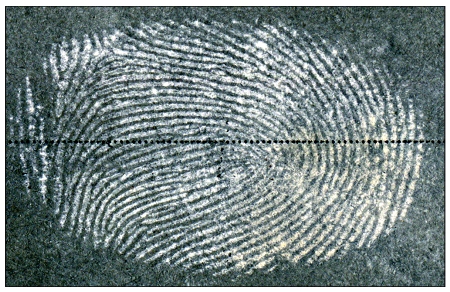Nov 7 2012
Identifying fingerprints on paper is a commonly used method in police forensic work, but unfortunately it is not easy to make those fingerprints visible. Now, scientists at the Hebrew University of Jerusalem have developed a new approach for making such fingerprints more readily readable.
 Example of negative image of fingerprint shown in new method of imaging developed by researchers at the Hebrew University of Jerusalem.
Example of negative image of fingerprint shown in new method of imaging developed by researchers at the Hebrew University of Jerusalem.
The new method, created by a team headed by Prof. Yossi Almog and Prof. Daniel Mandler of the Institute of Chemistry at the Hebrew University, uses an innovative chemical process to produce a negative of the fingerprint image rather than the positive image produced under current methods. Unlike the latter, the Hebrew University-developed process is nearly independent of the composition of the sweat residue left behind on the paper.
The new method is described in the current issue of the international, English-language edition of the journal Angewandte Chemie, published by the German Chemical Society.
In many criminal investigations, paper evidence plays an important role, and it is useful to know who has handled such documents as checks, paper currency, notes, etc. Studies have shown that less than half of the fingerprints on paper items can be made sufficiently visible to enable their identification. The main reason for this seems to be the highly variable composition of the sweat left behind on the paper.
The new procedure developed at the Hebrew University avoids these problems. It involves an inversion of an established method in which gold nanoparticles are first deposited onto the invisible fingerprints, followed by elemental silver, similar to the development of a black and white photograph.
In the conventional technique, the gold particles get stuck to the amino acid components of the sweat in the fingerprints, and then silver is deposited onto the gold. The result is quite often low-contrast impressions of the fingerprints. In the new method, the gold nanoparticles stick directly to the paper surface, but not the sweat. This technique utiliizes the sebum from the fingerprints as a medium to avoid this interference. (Sebum is an oily substance secreted by the sebaceous glands that helps prevent hair and skin from drying out.) Treatment with a developer containing silver then turns the areas with gold on them black, resulting in a clear, negative image of the fingerprint.
“Since our method relies only on the fatty components in the fingerprints, the sweaty aspects play no role in the imaging process,” said Prof. Almog. This technique also promises to alleviate another problem, he said. “If paper has become wet, it has previously been difficult to detect fingerprints because the amino acids in the sweat, which are the primary substrate for current chemical enhancement reactions, are dissolved and washed away by water, whereas the fatty components are barely affected.” Thus, the avoidance of the sweat aspect provides a further enhancement for police laboratory investigation, he observed.